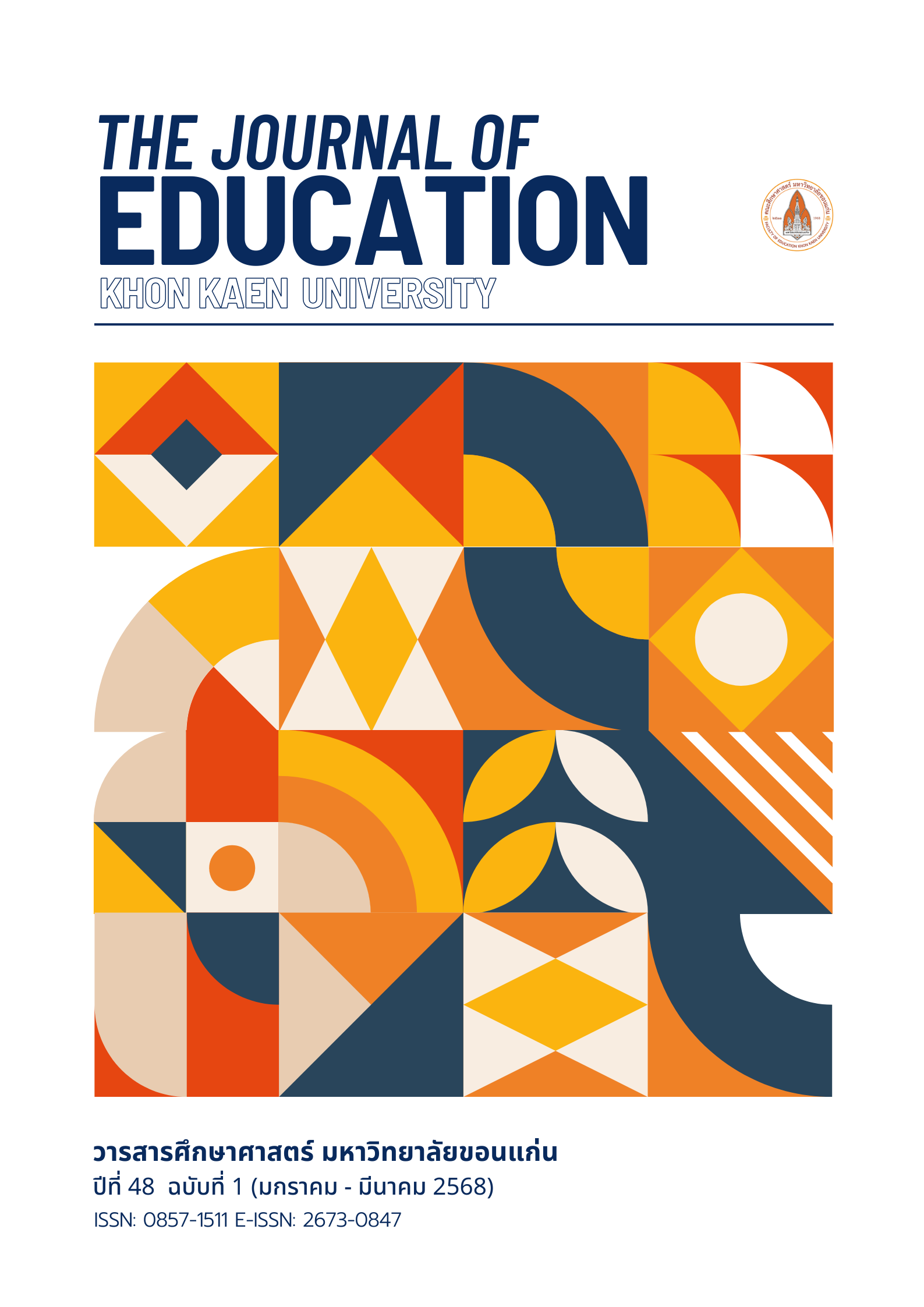ผลการใช้รูปแบบการจัดการเรียนรู้คณิตศาสตร์ตามแนวคิดการสร้างความรู้เพื่อพัฒนาความสามารถในการคิดวิเคราะห์ของนักเรียนชั้นมัธยมศึกษาปีที่ 1
Main Article Content
บทคัดย่อ
การวิจัยนี้มีวัตถุประสงค์เพื่อ 1) ศึกษาสภาพปัจจุบันและสภาพที่พึงประสงค์การจัดการเรียนรู้คณิตศาสตร์ตามแนวคิดการสร้างความรู้เพื่อพัฒนาความสามารถในการคิดวิเคราะห์ของนักเรียนชั้นมัธยมศึกษาปีที่ 1 2) สร้างและพัฒนารูปแบบฯ 3) ศึกษาผลการใช้รูปแบบฯ และ 4) ประเมินและรับรองรูปแบบฯ โดยใช้รูปแบบวิจัยและพัฒนา (Research & Development) 4 ระยะ 1) การวิจัย (Research: R1) 2) การพัฒนา (Development: D1) 3) การวิจัย (Research: R2) 4) ขั้นตอนที่ 4 การพัฒนา (Development: D2) กลุ่มตัวอย่างเป็นนักเรียนชั้นมัธยมศึกษาปีที่ 1/1 โรงเรียนหนองโนประชาสรรค์ ที่กำลังศึกษาในภาคเรียนที่ 2 ปีการศึกษา 2567 จำนวน 32 คน ได้มาโดยวิธีการสุ่มแบบกลุ่ม (cluster random sampling) เครื่องมือวิจัยประกอบด้วยแผนการจัดการเรียนรู้ แบบทดสอบวัดผลสัมฤทธิ์ แบบวัดความสามารถในการคิดวิเคราะห์ และแบบสอบถามความพึงพอใจ ผลการวิจัยพบว่า 1) สภาพปัจจุบันอยู่ในระดับน้อย สภาพที่พึงประสงค์อยู่ในระดับมาก 2) รูปแบบที่พัฒนาขึ้นเรียกว่า PIVARF Model มีองค์ประกอบคือ หลักการ วัตถุประสงค์ กระบวนการเรียนการสอน การประเมินผล และผลป้อนกลับ โดยมีขั้นตอนการสอน 6 ขั้น ได้แก่ เตรียมความพร้อมผู้เรียน (Prepare: P) ให้ผู้เรียนมีส่วนร่วม (Involve students Learning Activities: I) ตรวจสอบความเข้าใจ (Verify Students’ Understanding: V) เปิดโอกาสให้ผู้เรียนปฏิบัติโดยตรง (Action: A) สะท้อนความคิดเกี่ยวกับการเรียน (Reflect: R) และให้ฝึกโดยอิสระ (Free Practice: F) 3) ผลการใช้รูปแบบพบว่า มีประสิทธิภาพ 81.24/82.47 มีดัชนีประสิทธิผล 0.7043 ผลสัมฤทธิ์และความสามารถในการคิดวิเคราะห์หลังเรียนสูงกว่าก่อนเรียนอย่างมีนัยสำคัญทางสถิติที่ระดับ .05 นักเรียนมีความพึงพอใจในระดับมากที่สุด 4) ผลการประเมินและรับรองรูปแบบฯ อยู่ในระดับเหมาะสมมากที่สุด
Article Details

This work is licensed under a Creative Commons Attribution-NonCommercial-NoDerivatives 4.0 International License.
References
Bloom, B.S.. (1956). Taxonomy of Educational Objectives, the classification of educational goals – Handbook I: Cognitive Domain. New York: McKay.
Brooks, J. G., & Brooks, M. G. (1993). In search of understanding: The case for constructivist classrooms. Alexandria, VA: Association for Supervision and Curriculum Development.
Eisner, E. W. (1976). Educational connoisseurship and criticism: Their form and functions in educational evaluation. Journal of Aesthetic Education, 10(3/4), 135-150. https://doi.org/10.2307/3332067
Jonassen, D. H. (2011). Learning to solve problems: A handbook for designing problem-solving learning environments. New York, NY: Routledge.
Joyce, B., & Weil, M. (2009). Models of teaching (8th ed.). Boston, MA: Pearson.
Joyce, B., Weil, M., & Calhoun, E. (2015). Models of teaching (9th ed.). Boston, MA: Pearson.
Piaget, J. (1963). The origins of intelligence in children. New York, NY: W.W. Norton & Company.
Piaget, J. (1972). The psychology of the child. New York, NY: Basic Books.
Vygotsky, L. S. (1978). Mind in society: The development of higher psychological processes. Cambridge, MA: Harvard University Press.
Watts, M., & Fofili, Z. (1998). Towards critical constructivist teaching. International Journal of Science Education, 20(2), 173-185. https://doi.org/10.1080/0950069980200204
Buason, R. (2019). Research and development of educational innovations. Chulalongkorn University Publisher. [in Thai]
Bunchuailaeo, S. (2021). The study of mathematical fluency and flexibility related to equations of Grade 8 students (Master's thesis, Srinakharinwirot University). [in Thai]
Chaijaroen, S., (2016). Instructional Design: Principles and Theories to Practices. Pen Printing Company Limited: Khon Kaen, Thailand. [in Thai]
Chareonwongsak, K. (2020). Analytical thinking. Bangkok: Success Media. [in Thai]
Chuesuwanthawi, C. (2018). Mathematics teaching and learning. Chulalongkorn University Press. [in Thai]
Institute for the Promotion of Teaching Science and Technology (IPST). (2019). Mathematics learning area curriculum usage manual (revised edition, B.E. 2560) according to the basic education core curriculum, Buddhist Era 2551. The Teachers' Council of Thailand Printing House, Ladprao. [in Thai]
Kahong, N. (2022). The development of biology learning activities promoting growth mindset and learning achievement for Grade 10 students: A mixed methods research (Master's thesis, Mahasarakham University). [in Thai]
Khammani, T. (2021). Science of teaching: Cognitive processes in order to learn effectively (25th Ed). Bangkok: Chulalongkorn University Press. [in Thai]
Manthanoo Ch., (2022). The Development of a Science Teaching and Learning Model Based on Constructivist Theory and Cooperative Learning to Enhance Analytical Thinking Skills of Mathayomsuksa 3 Students. Journal of MCU Ubon Review., 7(1), 681-694. [in Thai]
Ministry of Education. (2017). Indicators and core learning content for mathematics learning strand (Revised B.E. 2560) according to the Basic Education Core Curriculum B.E. 2551. Bangkok: Agricultural Cooperative Federation of Thailand Printing House. [in Thai]
Ministry of Higher Education, Science, Research and Innovation. (2020). Policies and Strategies for Higher Education, Science, Research and Innovation 2020 – 2027. Retrieved 18 January 2022, from https://backend.tsri.or.th/files/trf/2/docs Policy_and_Strategy_of_Thailand_HESI_25632570_and_Thailand_SRI_Plan_2563-2565.pdf. [in Thai]
Munkham, S. (2010). Strategy ... teaching analytical thinking. (5th ed.). Bangkok: pakpim.
Munkham, S., & Munkham, O. (2010). 19 methods of learning management: To develop the thinking processes (9th ed.). Bangkok: Parbpim Printing. [in Thai]
National Institute of Educational Testing Service (Public Organization). (2020). Report of the National Educational Testing Service (O-NET) for Grade 9 students, academic year 2020. National Institute of Educational Testing Service (Public Organization). [in Thai]
NongNo Prachasan School. (2017). Self-assessment report (SAR) of the educational institution, academic year 2017. NongNo Prachasan School. [in Thai]
Office of the Basic Education Commission. (2017). Driving Thai secondary education 4.0. For employment in the 21st century. Bangkok: Agricultural Cooperative Assembly Press Thailand. [in Thai]
Petchraporn K., (2020). Science of learning management. Bangkok: Faculty of Education, Suan Sunandha Rajabhat University. [in Thai]
Phanit, W. (2017). The Ways to Create Learning for Students in the 21st Century (4th ed.). Bangkok: THE SIAM COMMERCIAL FOUNDATION. [in Thai]
Phongphuangphet Ph., Sitti S., & PiyaKul A., (2017). The Development of Science Teaching Model Based on Constructivist Theory to Enhance Knowledge Construction Ability and Eagerness to Learn of PrathomSukSa 4 Students. Journal of Yala Rajabhat University, 12(2), 93-106. [in Thai]
Phonyiam, T. ., Phibranchon, S. ., & Panprueksa, K. . (2019). THE STUDY OF PHYSICS PROBLEM SOLVING ABILITY AND PHYSICS ACHIEVEMENT ON MOMENTUM AND COLLISIONS OF TENTH GRADE STUDENTS 2 BY USING THE INQUIRY METHOD INCORPORATED WITH POLYA’S PROBLEM SOLVING TECHNIQUE. Journal of Education and Innovation, 22(1), 84–95. [in Thai]
Promwong, C. (2013). Media Performance Testing or Teaching Series. Silpakorn Education and Research Journal, 5(1), 7-20. [in Thai]
Sinlarat, P. (2020). The Future of Thai Teacher Education and Literacy Development. URNAL OF TEACHER PROFESSIONAL DEVELOPMENT, 1(1), 1-7. [in Thai]
Sintapanont, S., et al. (2019). Various teaching methods for developing quality of Thai youth. Bangkok: 9119 Technique Printing. [in Thai]
Sroisaeng, N. (2017). The effects of a 7-step inquiry-based learning cycle emphasizing the use of scientific evidence combined with graphic organizer techniques on analytical thinking and learning achievement in biology of Grade 10 students (Thesis, Faculty of Science, Burapha University). [in Thai]
Wongyai, W., & Phatthaphon, M. (2019). Learning management that enhances innovation mindset. Center for Curriculum and Learning Innovation Leadership, Srinakharinwirot University. [in Thai]
Yuphuk, S. (2019). The Development of an Instructional Model Based on Constructivism to Promote Critical Thinking for Problem Solving and Scientific Mind for Mathayom Suksa 1 Students. Journal of Education Sakon Nakhon Rajabhat University (Online), 1(1), 63-73. [in Thai]

